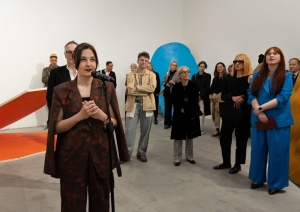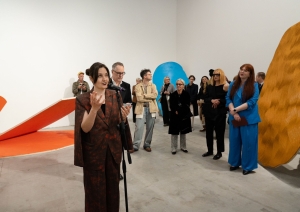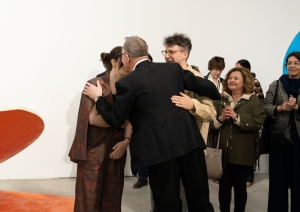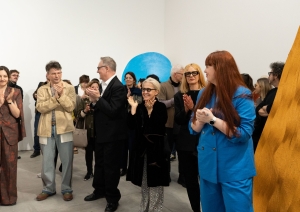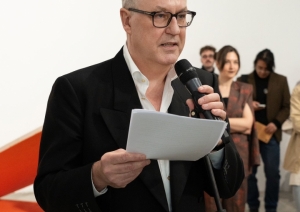Latvian Pavilion, represented at the 60th International Art Exhibition - La Biennale di Venezia by the artist Amanda Ziemele with an exhibition “O day and night, but this is wondrous strange... and therefore as a stranger give it welcome” has opened today, inviting the viewers to take an open and accepting stance in order to best experience her chosen original language of painting.
A cloud which fell quasi-dramatically, like tragic Icarus, a victim of an excessive ambition (his wings a Proustian memory-landscape in ruins); a lost petal in a corner, acting as a shelter in times of turmoil and uncertainty; a feeling never forgotten, a stranger-soon-a-lover, a much desired resurrection, or a tainted failure, the allure of loss… This is Amanda Ziemele’s newly defined painting as a spatial extravaganza of irregular geometry and organic volume.
Following the Shakespearian thread from Edwin A. Abbott’s 1884 novella Flatland, Ziemele unfolds the masteries of three dimensions in a fluid transition from flatland to throughtland by creating a microcosm of embrace and unconditional hospitality under thread. Throughout her practice, Amanda Ziemele has created painterly environments that are often choreographed across all parameters of a given space. In a subtle though bold act of subversion, she transforms the Latvian Pavilion’s interior into a living organism. Taming space and animating dimensions, Ziemele will welcome viewers into a polyphonic habitat of hospitality.
The Pavilion is curated by Adam Budak and commissioned by the Ministry of Culture of the Republic of Latvia, commissioner Daiga Rudzāte.
“Eight figures of heightened identity and monochromatic (sur)faces – an army of objectiles in a whirlpool of corporeal mise-en-abîme – stoically, and yet passionately, rehearse the genre of a conversation piece, blessed by “Flatland’s” gift of modesty and its belief in imagination and solid humanity [..]. Amanda Ziemele’s is an emancipatory project; against the preconceived discipline of space, the viewer enters an illusionary hybrid zone of sharing and solace, protection and vulnerability, composed of haptic forms in dispersion and collapse. Shells and nests, shadows and echoes, and supporting structures negotiating in vain; ambiguity of a sublime nature, between beauty and danger, an uncanny factor, abstract yet familiar. It is transgression at work: resisting gravity, forms levitate with both a joy and hopelessness. Hospitality is a critical act that is beyond the threshold of the possible – a paradox. At the confluence of absence and presence, daylight is an instrument inviting the viewer to a self-reflective journey through a world in disarray and with no measure, a displaced universe of mutual hospitality, a warped space where the other is a gift. This is Amanda Ziemele’s version of a mature space, a counterphantasmagoria, resisting exhaustion and fatigue, a space with an attitude, ready to think and host the irregular world of contemporary society,” said the Curator Adam Budak.
Amanda Ziemele’s project for the Latvian Pavilion has come to life through cooperation with the architect Niklāvs Paegle and writer Agnese Krivade. Krivade's publication complements Amanda Ziemele's exhibition in Venice, which unfolds the conceptual idea of the exhibition in the format of interviews and essays.
Architect Niklāvs Paegle described the exhibition as “eight figures caught in the space. Newcomers to this world, trying their best to exist; clumsy, tired but curious giants. Gravity is a new concept for them, they use whatever is at hand. Their skeletons are made of wood and torsos of stretched canvas, with limbs holding onto Arsenale rafters, shoulders leaning against walls. Oily creatures standing on tiptoes, centre of mass off balance. Here they are, testing and daring the limits of this masonry enclosure. Perhaps triggered by a sparring afterparty of escape from flatness, an awe to perpetual sunrise, or simply attempt to find their way of existing in this world, in this space, together. Bent, folded, wrapped and warped around themselves – some excelling at it, some exhausted and some just about holding on "to make it" in here,” he said.
Outlining Ziemele’s artistic expressions, Commissioner Daiga Rudzāte characterized her as a “unique painter in the Latvian contemporary art scene. “It is not easy – in fact, it is impossible – to place her within the framework of any tradition or movement. Her gestures are characterised by unexpectedness and challenge – but not a shocking one, rather one that is able to catapult its viewer, without them ever expecting it, to a place where a scene completely unlike the usual opens up. And from this point of view it is possible to understand that the ability to accept, to rejoice, and to welcome is what helps us live life,” Rudzāte said.




